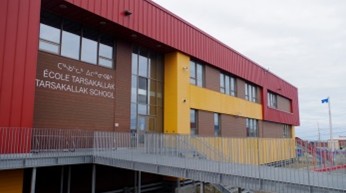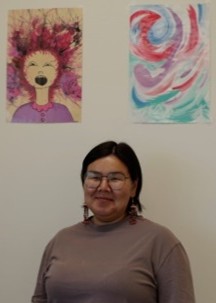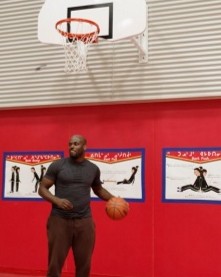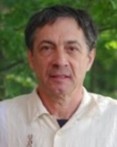
By François Bellemare
Like many visitors, I was filled with admiration while walking around the Tarsakallak School, which serves the Nunavik village of Aupaluk in the far reaches of northern Quebec. A new building; welcoming staff; smiling students. And in the interview she granted me, assistant principal Nuna Akphahaktak did not shy away from presenting both sides of the coin.
She comes from one of the founding families of the community, the people of Kangirsuk who occupied the area on a seasonal basis before settling down in the 1980s. “Like most of the current school’s parents, I attended the school as a child. I studied the specific curriculum for Nunavik: kindergarten and early primary school entirely in Inuktitut. And from grade 3 on, gradual integration into the French curriculum (in my case); or into English, depending on the parents’ choice.”
Academic Versus Traditional
Representing these newly trilingual Inuit, Mrs. Akphahaktak quit school after Secondary 2, like many of her classmates. “I spent a lot of time with my extended family, in traditional activities: sewing, and taking care of the elderly or very young children. And often in outdoor activities: hunting, fishing, picking small fruits (blueberries, cloudberries) or preparing eider down, which is used to insulate winter clothing. Later on, I became an Inuit language and culture teacher… in the school of my own youth! And eight years later, assistant principal.”
Her tasks resemble those of any assistant principal in a southern school, but with the specific demands of Nunavik communities added on. “Depending on the year, we have between 2 and 6 enrollments in kindergarten, 30 in elementary school and 20 to 25 in high school.” With a total of 50 to 60 students, the school comprises 25% of the total population of this “northern village,” the official way to refer to Nunavik’s 14 municipalities. That’s double the Quebec average, which wavers between 10% and 12%.
Obstacles
“Some of our students get the support they need at home,” she says, “including help with homework, supported schedules, and a balanced diet. Others get much less help.” She relates the case of students arriving in the morning without having done their homework the night before, carrying no lunch; sometimes they haven’t even eaten breakfast. “How can you study under these conditions?” A sad refrain heard throughout Quebec. But here, nestled in the heart of Ungava Bay, she tells us frankly that it is a more acute problem.
“The legalization of cannabis had already increased drug consumption because the SQDC delivers by mail. But now, our villages are also beset with a wave of new hard drugs, difficult to detect in packages delivered by airplane. For sure, in a locality limited to three or four roads, a lot of people know who is selling these often lethal products. But no one dares denounce them.” Mrs. Akphahaktak emphasizes that even though a small minority of students are affected by this scourge, it can easily disrupt an entire group. “The two to three last years of high school are the most difficult in terms of school attendance. For example, last year, none of our students graduated.”
The Basketball Teacher Tries a Three
This night in the school gymnasium, 15 young Inuit play volleyball and basketball. Watching them sink threes, their skill level is impressive. Nunavik teams are doing better at interregional competitions. Several factors explain this, including the basketball clinics given in the different villages by a special teacher: Quesly-Marie Norésias.
All of Nunavik’s schools count on teachers from the south, like this Quebec City native who holds a degree in exercise science. Coming from the Haitian diaspora, one could even say that in the communities north of the north, he himself embodies « the south of the south. » He has trained and played at an elite level: in track and field (Quebec high jump champion), then in basketball with the Académie d’Alma, in Lac St. Jean. He played collegiate basketball at the University of Providence in Montana. He is now an assistant coach for the Montreal Alliance, part of the Canadian Elite Basketball League.
For the Kativik School Board, which runs Nunavik’s schools, he takes an original approach by combining basketball with math. Mr. Norésias explains: “Students try a series of shots at the basket from different positions on the court. They have to calculate their own results: the progression of shots made, their percentage from each position, etc. It’s all inspired by Hoop Lab – a math and basketball learning platform founded by Francis Ihza and distributed by the L’Atelier 803 youth organization in Thetford Mines.”
“The exercise provides an incentive for extracurricular practice, in addition to encouraging students to work on their math as much as in the sport itself. In short, we aim for a triple result.” A metaphor for the three point basket?
The teacher smiles at the figure of speech: “The approach is designed to get the student to track their own consistency and progress.” But this approach has to be adapted to each place he goes.
Mr. Norésias admits having experienced culture shock the first time he came to Nunavik. “Young people up here don’t manage their emotions the same way that we do in the South” he explains, recalling how students sometimes answered him. “In certain cases, it can be traced back to a difficult family circumstance; or just the cultural gap between Indigenous people and Allophones… In any event, it was tough for me to confront difficult situations when I insisted on commitment and effort. But with communication, patience, and understanding, we can get some beautiful things done. And sometimes, we can change lives!”
From Informal to Formal
For the visitor from the South, what is most startling is the high school dropout rate in Nunavik: 73%, says the School Board. And check out the apparent professional competence observed among many residents: air traffic controllers and nursery school teachers; heavy machinery mechanics and municipal managers. “It’s true that I am emblematic of this contradiction,” says Mrs. Akphahaktak, “as I am responsible for encouraging perseverance among our high school students… which I myself did not complete.”
Interviewed in Kuujjuaq, Jeannie Dupuis, Assistant Director General at the Kativik School Board, reminds me that the mere notion of school education is a recent one in Inuit society. Which would explain the high number of self-taught individuals in a whole host of jobs. That being said, almost all of the local people interviewed for this series of articles agree that “formal” training, with a diploma, is now essential. Especially given the self-governance that Inuit authorities are demanding.
“A big blow,” Mrs. Akpahaktak recognizes, “was the fire that ravaged our old school building in 2014. But since then, the government has built this new building.” The School Board is making efforts to recruit permanent staff – a challenge without end in a Nunavik that is constantly growing demographically. “A big plus,” she says, “is that we now have a great team at the school. They are super motivated. And don’t forget our extracurricular activities, which nourish perseverance; nor the role of certain families active in them. For every problem, the school seeks a solution.”
Nunavik Journalism Project 1975-2025
Under this title, evoking the 50th anniversary of the James Bay and Northern Quebec Agreement (JBNQA) from which Nunavik gets its governing structures, the author is writing a series of exclusive articles and interviews on that region. François Bellemare’s reports are funded by an excellence grant from the Association des journalistes indépendants du Québec (AJIQ).




Leave a Reply